Bathtub
How to Remove Bathtub Drain Plug
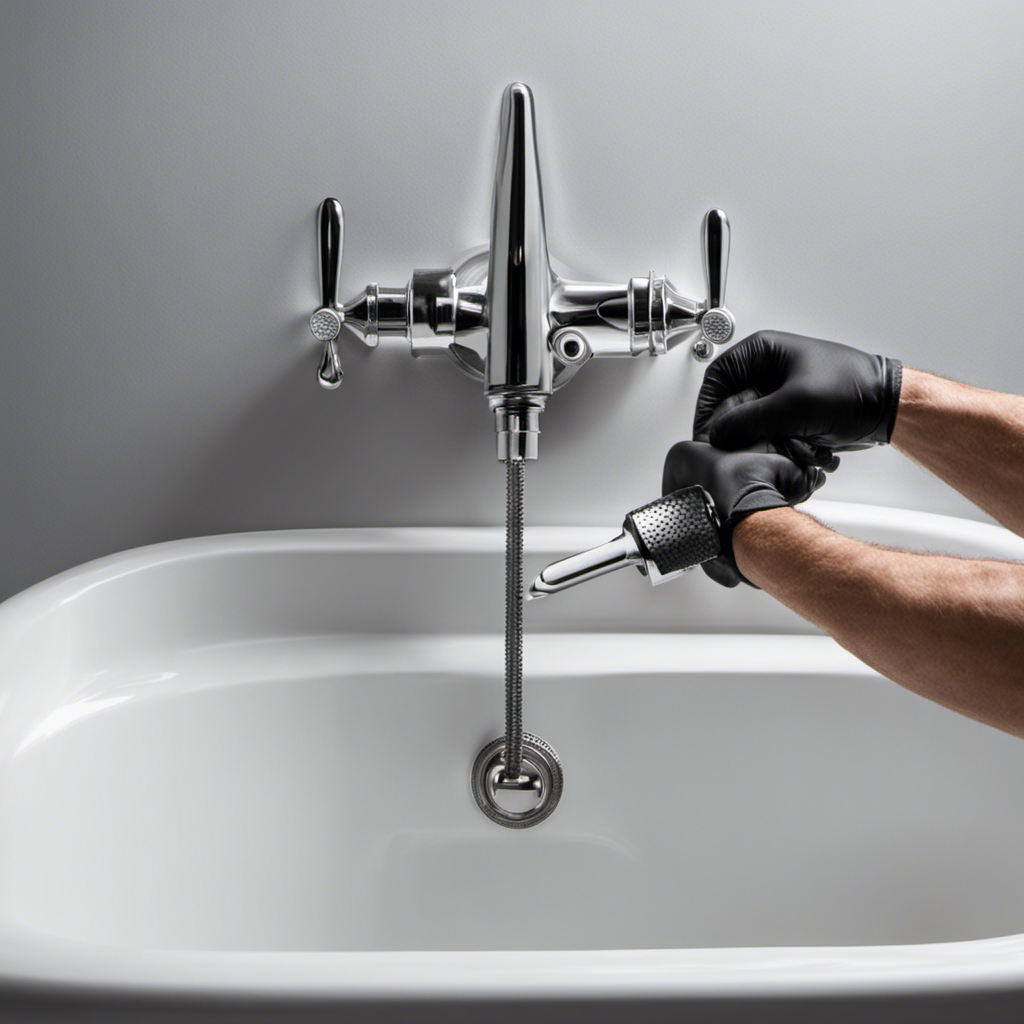
I’ve been there – standing in the shower, ankle-deep in water, desperately trying to figure out how to remove that stubborn bathtub drain plug. Well, fear no more!
In this article, I’ll guide you through the step-by-step process of getting that pesky plug out once and for all. With the right tools and a little know-how, you’ll have your drain flowing freely in no time.
So, let’s dive in and conquer this drain plug dilemma together!
Key Takeaways
- Different types of bathtub drain plugs require different removal techniques
- Using a plunger or homemade drain cleaner can help loosen stubborn plugs
- Clearing the bathtub area and having the necessary tools and materials ready is important for the removal process
- If all else fails, it may be necessary to call a professional plumber for assistance.
Tools and Materials Needed
You’ll need a pair of pliers, a screwdriver, and a drain removal tool to remove the bathtub drain plug. When it comes to bathtub drain stopper replacement or troubleshooting bathtub drain plugs, having the right tools is essential.
The first tool you’ll need is a pair of pliers. These will help you grip and twist the drain plug.
Next, grab a screwdriver. This will be used to remove any screws or fasteners holding the drain plug in place.
Finally, a drain removal tool is necessary. This specialized tool is designed to fit into the drain and unscrew the plug.
With these tools in hand, you’ll be well-equipped to remove the bathtub drain plug and tackle any issues with your drain.
Understanding Different Types of Bathtub Drain Plugs
When it comes to bathtub drain plugs, it’s important to understand the different types that are commonly used.
There are several common drain plug types, including the push-pull, the lift-and-turn, and the toe-touch. Each type has its own unique mechanism for opening and closing the drain.
However, sometimes removing these plugs can be a challenge, especially if they have become stubborn over time.
Common Drain Plug Types
To identify common drain plug types, check if your bathtub has a lift-and-turn, push-pull, or toe-touch style plug. These different materials and installation methods offer varying levels of convenience and functionality.
The lift-and-turn plug is made of durable materials like brass or stainless steel, and it requires you to lift and turn the plug to open or close the drain.
The push-pull plug is typically made of plastic and is easy to operate by simply pushing it down to close the drain or pulling it up to open it.
Lastly, the toe-touch plug is constructed with a rubber seal and is activated by pressing it with your toe.
Now that you know the common drain plug types, let’s move on to the next section and learn how to remove stubborn plugs.
Removing Stubborn Plugs
If a stubborn plug is stuck, try using a plunger to dislodge it. This simple tool can create the necessary suction to loosen the plug and allow water to flow freely again. However, if the plunger doesn’t work, there are other methods you can try to remove the stuck plug.
Here are some options:
-
Using a homemade drain cleaner: Mix equal parts of baking soda and vinegar and pour it down the drain. Let it sit for a few minutes before flushing it with hot water. The chemical reaction can help dissolve any buildup that may be causing the plug to stick.
-
Using a wire hanger: Straighten a wire hanger and create a small hook at one end. Insert the hook into the drain and try to catch onto the plug. Gently pull and twist to release the plug.
-
Using lubricant: Apply a generous amount of dish soap or petroleum jelly around the edges of the plug. This can provide lubrication and make it easier to remove.
Remember to always use caution when attempting to remove a stuck plug, and if all else fails, it may be best to call a professional plumber.
Preparing the Bathtub Area
First, gather all the necessary tools and materials for preparing the bathtub area. To clear clogs and ensure proper maintenance, it’s important to have a few key items on hand. You’ll need a plunger, a drain snake, a bucket, rubber gloves, and a wrench. These tools will help you tackle any clog and keep your bathtub drain running smoothly.
Before starting, make sure to remove any items around the bathtub that may obstruct your access. Clear the area of any shampoo bottles, soap dishes, or bath toys. Also, place a bucket nearby to catch any water that may spill during the process.
Removing the Stopper From Lift-And-Turn Drain Plugs
Now, you’ll need to twist and lift the stopper to remove it from your bathtub’s drain. Removing a stuck drain plug can be a frustrating task, but with the right technique, it can be done effectively. Here’s how to do it:
-
Apply lubricating oil: Before attempting to remove the drain plug, apply a generous amount of lubricating oil to the stopper. This will help loosen any rust or debris that may be causing it to stick.
-
Use pliers: If the stopper is still stuck, you can use a pair of pliers to get a better grip. Simply grab onto the stopper and twist it counterclockwise to loosen it. Be careful not to apply too much force, as this could damage the drain.
-
Clean the drain: Once you have successfully removed the stopper, take the opportunity to clean the bathtub drain thoroughly. Use a drain brush or a mixture of baking soda and vinegar to remove any hair or soap scum that may have accumulated.
Removing the Stopper From Push-Pull Drain Plugs
When it comes to removing the stopper from push-pull drain plugs, there are a few key points to keep in mind.
First, you’ll need a few tools for the removal process, including a screwdriver, pliers, and possibly a wrench.
The step-by-step removal process involves loosening the screw, pulling out the stopper, and disconnecting any linkage.
However, there are common challenges that may arise, such as stubborn screws or corroded parts, but solutions such as applying lubricant or using a wrench can help overcome these obstacles.
Tools Needed for Removal
To remove the bathtub drain plug, you’ll need a pair of pliers and a flathead screwdriver. Proper tools selection is crucial for a successful removal. Here’s a list of tools you’ll need:
- Pliers: These will help you grip and turn the drain plug, allowing you to loosen it.
- Flathead screwdriver: This tool is useful for prying and lifting the drain plug out of its position.
- Bucket or container: It’s important to have a container nearby to catch any water that may come out when removing the plug.
Using the right tools and following the proper removal technique ensures a smooth process. Now that we have the necessary tools ready, let’s move on to the step-by-step removal process.
Step-By-Step Removal Process
First, grip the drain plug with the pliers and turn it counterclockwise to loosen it. Understanding different types of bathtub drain plugs is crucial for successful removal. Some common types include lift-and-turn, push-and-pull, and toe-touch plugs. Each type requires a slightly different approach for removal.
For lift-and-turn plugs, after loosening it with the pliers, lift the plug up and twist it counterclockwise to fully remove it.
Push-and-pull plugs can be removed by pulling up on the plug and wiggling it side to side until it comes out.
Toe-touch plugs can be released by pushing down on the plug and turning it counterclockwise.
If the drain plug is stubborn and won’t budge, try using a drain key or a drain removal tool to provide more leverage and strength.
Common Challenges and Solutions
One common challenge when removing a bathtub drain plug is encountering a stubborn plug that won’t budge. It can be frustrating when you’re trying to clear a clog or perform maintenance on your bathtub, but the plug just won’t come out. Here are some tips to help you overcome this challenge:
-
Apply lubricant: Use a lubricant like WD-40 or silicone spray to loosen the plug. Spray it around the edges of the plug and let it sit for a few minutes before trying to remove it.
-
Use pliers: If the plug is still stuck, you can try using pliers to grip it and twist it out. Make sure to protect the finish of your plug by wrapping it in a cloth before using the pliers.
-
Heat it up: Another method is to heat the plug with a hairdryer or hot water. The heat can expand the metal, making it easier to remove.
Removing the Stopper From Toe-Touch Drain Plugs
You can easily remove the stopper from toe-touch drain plugs by following these steps.
First, locate the small lever or button on the drain plug. This is usually found near the edge of the bathtub. Once located, press the lever or button down firmly. This will release the stopper and allow it to be pulled out of the drain. If the stopper is difficult to remove, you may need to wiggle it gently from side to side while pulling upwards.
To ensure proper functioning of your toe-touch drain plug, it is important to regularly clear any clogs and perform basic maintenance. This can be done by using a plunger to dislodge any debris or by using a drain snake to physically remove the clog. Regularly cleaning and inspecting the stopper for any damage or buildup will also help to prevent future clogs.
Now that you know how to remove the stopper from toe-touch drain plugs, let’s move on to the next step: removing the trip lever assembly from bathtub drain plugs.
Removing the Trip Lever Assembly From Bathtub Drain Plugs
When it comes to bathtub drain plugs, one common issue that homeowners often encounter is the need to remove the trip lever assembly. This can be a tricky process, but with the right techniques, it can be done effectively.
In this discussion, I will guide you through the step-by-step process of removing the trip lever assembly from your bathtub drain plug, as well as address some of the most common issues you may come across during this task.
Trip Lever Removal Techniques
To remove the bathtub drain plug, try wiggling the trip lever back and forth. This motion can help loosen any debris or sediment that may be causing the drain plug to stick. If wiggling the trip lever doesn’t work, you may need to take additional steps to remove the drain plug. Here are a few techniques you can try:
-
Use a pliers: Gently grip the trip lever with a pair of pliers and rotate it counterclockwise to unscrew it from the drain pipe.
-
Apply lubricant: Spray a small amount of lubricant, such as WD-40, onto the trip lever and let it sit for a few minutes. Then, try wiggling or unscrewing the lever again.
-
Call a professional: If all else fails, it may be necessary to call a professional plumber to remove the drain plug and troubleshoot any issues with the trip lever.
Remember to always exercise caution when working with plumbing fixtures and consider seeking professional help if needed. Proper trip lever maintenance and troubleshooting can help keep your bathtub drain working smoothly.
Common Bathtub Drain Issues
After learning how to remove the trip lever, it’s crucial to understand common bathtub drain issues that may arise.
One common problem is a clogged drain, which can be resolved through bathtub drain cleaning. Over time, hair, soap scum, and other debris can accumulate and block the drain, causing water to drain slowly or not at all. To address this issue, a drain cleaning tool or a mixture of baking soda and vinegar can be used to dissolve the clog.
Another common issue is a faulty or damaged drain, which may require bathtub drain installation. This involves removing the old drain and replacing it with a new one to ensure proper drainage.
Now that we’ve covered common bathtub drain issues, let’s move on to removing the strainer from bathtub drain plugs.
Removing the Strainer From Bathtub Drain Plugs
You can easily remove the strainer from bathtub drain plugs by using a screwdriver.
To troubleshoot bathtub drain plugs, follow these steps:
-
Step 1: Locate the drain plug in your bathtub. It is usually located in the center of the tub, underneath the faucet.
-
Step 2: Insert the tip of the screwdriver into one of the holes on the strainer. Apply gentle pressure and twist counterclockwise to loosen the strainer.
-
Step 3: Continue twisting until the strainer is completely loose. Carefully lift it out of the drain, making sure not to drop any small parts down the drain.
Removing the strainer is an important step in troubleshooting bathtub drain plugs. It allows you to inspect and clean the drain, as well as remove any hair or debris that may be causing a clog.
Clearing Clogs in Bathtub Drain Plugs
If your bathtub is clogged, try using a plunger to clear the blockage. This is one of the most effective and common troubleshooting techniques for clearing clogs in bathtub drain plugs.
To begin, fill the tub with enough water to cover the rubber part of the plunger. Place the plunger over the drain and pump it up and down vigorously. The suction created by the plunger will force the clog to dislodge and move down the drain.
If the plunger doesn’t work, you can try using a drain snake or a chemical drain cleaner specifically designed for clearing clogs in bathtubs. These tools can help break up and remove stubborn clogs.
If these methods fail, it may be necessary to replace the bathtub drain plug entirely.
Replacing the Bathtub Drain Plug
To replace the bathtub drain plug, simply unscrew the old one and screw in the new one. It’s a straightforward process that can be done in just a few simple steps. Here’s how:
-
First, locate the drain plug in your bathtub. It is typically located in the center of the tub, near the bottom.
-
Use a screwdriver or a pair of pliers to unscrew the old drain plug in a counterclockwise direction. Be careful not to apply too much force, as this may damage the drain or surrounding area.
-
Once the old plug is removed, take the new drain stopper and screw it into place in a clockwise direction. Make sure it is securely fastened and does not wobble.
By following these steps, you can easily replace your bathtub drain plug and ensure that your tub drains smoothly without any issues.
If you encounter any problems or difficulties during the process, it’s always a good idea to consult a professional plumber for further assistance.
Maintenance Tips for Bathtub Drain Plugs
For proper maintenance of your bathtub drain plug, it’s important to regularly clean it to prevent clogs and buildup. Neglecting this simple task can lead to slow draining, foul odors, and even complete blockages in your bathtub drain. To help you keep your drain plug in optimal condition, here are some maintenance tips:
| Maintenance Tips for Bathtub Drain Plugs |
|---|
| 1. Remove hair and debris from the drain plug after each use. |
| 2. Use a drain cleaner or vinegar and baking soda mixture to dissolve any buildup. |
| 3. Regularly check the rubber gasket or seal for wear and tear. Replace if necessary. |
| 4. Avoid using harsh chemicals or abrasive cleaners that can damage the drain plug. |
| 5. Consider using a drain strainer to catch hair and other debris before it reaches the drain plug. |
Frequently Asked Questions
How Do I Prevent My Bathtub Drain Plug From Getting Clogged?
To prevent my bathtub drain plug from getting clogged, regular maintenance is crucial. I make sure to remove any hair or debris from the drain and use a drain cover to catch any potential clog-causing substances.
Can I Use a Plunger to Remove a Bathtub Drain Plug?
Sure, I can definitely help you with that! When it comes to removing a bathtub drain plug, there are a few alternatives to using a plunger and you can even do it without any tools.
What Should I Do if the Drain Plug Is Stuck and Won’t Come Out?
To loosen a stuck drain plug, I would first try using a pair of pliers or a wrench to apply some force. If that doesn’t work, I might use a lubricant or even call a professional plumber for assistance.
Is It Necessary to Remove the Trip Lever Assembly to Replace the Bathtub Drain Plug?
Yes, it is possible to replace the bathtub drain plug without removing the trip lever assembly. However, it is important to ensure that the new drain plug is compatible with your bathtub’s plumbing system.
Are There Any Alternative Methods for Removing a Stubborn Bathtub Drain Plug?
There are alternative methods for removing a stubborn bathtub drain plug. One option is to use a plunger to create suction and pull out the plug. Another method involves using a drain snake to dislodge and remove the plug.
Conclusion
In conclusion, removing a bathtub drain plug may seem like a daunting task, but with the right tools and knowledge, it can be done easily. By understanding the different types of drain plugs and following the proper steps, you can successfully remove the stopper or strainer and clear any clogs that may be causing issues.
Remember to replace the drain plug properly and perform regular maintenance to ensure a smoothly functioning bathtub. Just like unclogging a drain, removing a drain plug requires patience and perseverance, as it is a small but important task in maintaining the overall functionality of your bathroom.
With an impeccable eye for detail and a passion for bathroom-related, Ava leads our editorial team gracefully and precisely.
Under her guidance, Best Modern Toilet has flourished as the go-to resource for modern bathroom enthusiasts. In her free time, you might find Ava exploring antique shops and looking for vintage bathroom fixtures to add to her collection.
Bathtub
What Makes a Toilet Less Likely to Clog

Here is what we have discovered about preventing clogged toilets:
- A good flush is key. By using proper flushing techniques, we can prevent blockages and ensure smooth operation.
- Toilet paper usage is another factor to consider. Being mindful of how much we use can make a big difference.
- Regular maintenance and cleaning also play a crucial role in preventing clogs.
- Moreover, if we avoid flushing non-flushable items and consider upgrading to a high-pressure toilet, we can further reduce the risk of clogging.
Key Takeaways
- Use the appropriate amount of water to flush waste effectively.
- Avoid flushing non-flushable items such as baby wipes, dental floss, and cotton swabs.
- Regular maintenance and cleaning of the toilet bowl, drain, and tank are essential to prevent clogs.
- Consider upgrading to a high-pressure toilet for improved flushing power and reduced likelihood of clogs.
Proper Flushing Techniques
To ensure a toilet is less likely to clog, we must use the proper flushing techniques. Water conservation during flushing plays a crucial role in preventing clogs. It’s essential to use the appropriate amount of water to flush away waste effectively without wasting excess water.
When flushing, a high water pressure is necessary to ensure efficient removal of waste from the toilet bowl. Adequate water pressure creates a strong force that helps carry away debris and prevents it from getting stuck in the drainage system. However, excessively high water pressure may lead to splashing or overflowing, which can cause clogs.
Therefore, it’s important to strike a balance between water pressure and conservation to maximize flushing efficiency while minimizing the risk of clogs.
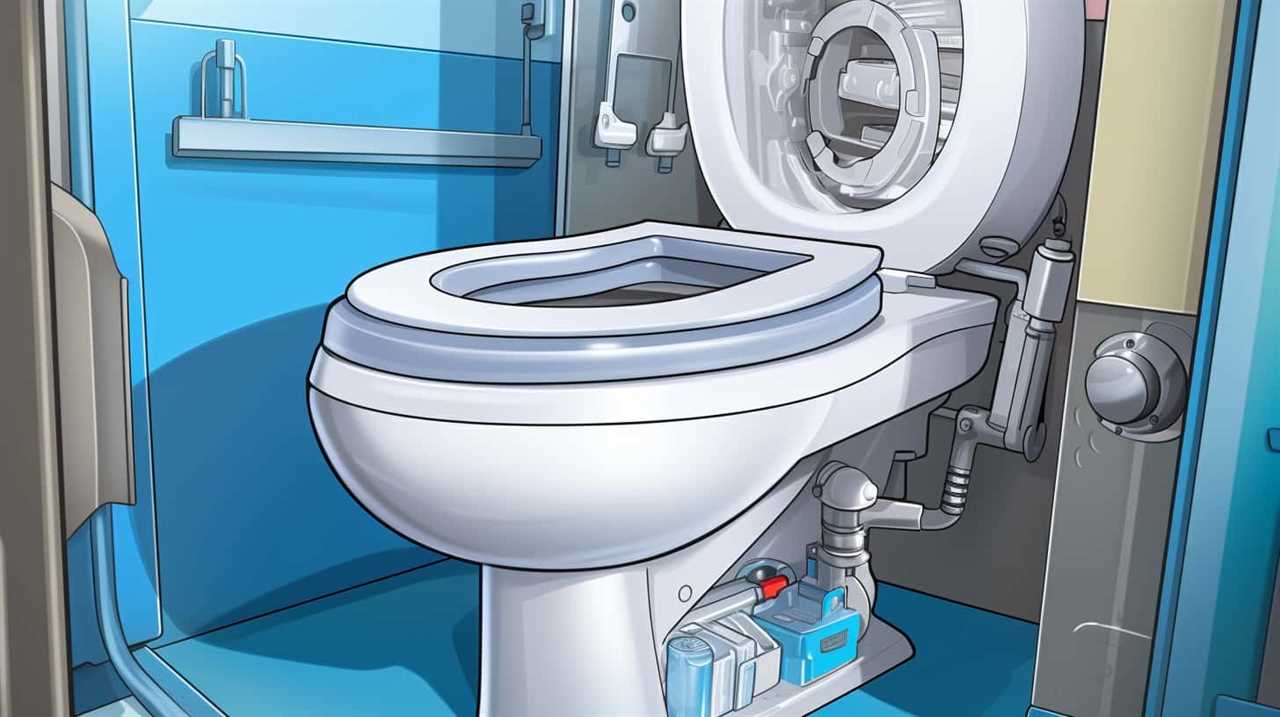
Toilet Paper Usage
When it comes to preventing clogs, our toilet paper usage is a crucial factor to consider. Not all toilet papers are created equal, and some are more prone to causing blockages than others. To help you make an informed choice, let’s analyze the environmental impact and explore alternatives to traditional toilet paper.
Toilet paper usage can have a significant environmental impact. The production of toilet paper involves cutting down trees and requires a substantial amount of water and energy. Additionally, the transportation and disposal of toilet paper contribute to carbon emissions and waste accumulation.
Considering alternatives to toilet paper can help reduce the environmental impact. Bidets, for example, provide a more hygienic and efficient way to clean oneself after using the toilet. Other options include reusable cloth wipes or bamboo-based toilet paper, which is more sustainable than traditional options.
By understanding the environmental impact of our toilet paper usage and exploring alternatives, we can make more conscious choices that are both eco-friendly and effective in preventing clogs.

Now, let’s delve into the next section about regular maintenance and cleaning.
Regular Maintenance and Cleaning
Maintaining and cleaning our toilets regularly is essential in preventing clogs and ensuring optimal performance. Neglecting this aspect of toilet care can lead to unpleasant and costly issues down the line. To keep our toilets in top shape, here are some important steps to follow:
- Toilet bowl scrubbing: Regularly scrubbing the toilet bowl removes built-up grime and prevents blockages. Use a toilet brush and a mild cleaner to thoroughly clean the bowl, paying special attention to the rim and under the rim.
- Drain inspection: Periodically inspecting the drain can help identify potential clogging issues before they become major problems. Check for any signs of blockage, such as slow draining or unusual noises. If necessary, use a plunger or a drain snake to clear any debris.
- Cleaning the tank: It’s also important to clean the toilet tank to prevent sediment buildup. Remove the tank lid and use a sponge or brush to clean the inside surfaces. Be sure to flush the tank thoroughly after cleaning.
- Regular maintenance schedule: Establish a regular maintenance schedule to ensure that cleaning and inspection tasks are performed consistently. This will help prevent clogs and maintain optimal toilet performance.
Avoiding Flushing Non-Flushable Items
One important step in preventing toilet clogs is to avoid flushing non-flushable items. Properly disposing waste and educating children about what can be flushed are crucial aspects of maintaining a functional toilet system. To emphasize the significance of this step, let’s take a look at the following table:
| Non-Flushable Items | Why They Shouldn’t Be Flushed | Proper Disposal Method |
|---|---|---|
| Baby wipes | They do not break down easily | Dispose in the trash |
| Dental floss | Can cause clogs and tangles | Throw in the trash |
| Cotton swabs | Can get stuck and form blockages | Dispose in the trash |
Disposing waste properly involves recognizing that some items, such as baby wipes, dental floss, and cotton swabs, should not be flushed down the toilet. Instead, they should be placed in the trash. Educating children about these guidelines is essential to prevent accidental flushing of non-flushable items. By following these practices, we can reduce the risk of toilet clogs and maintain a properly functioning toilet system.
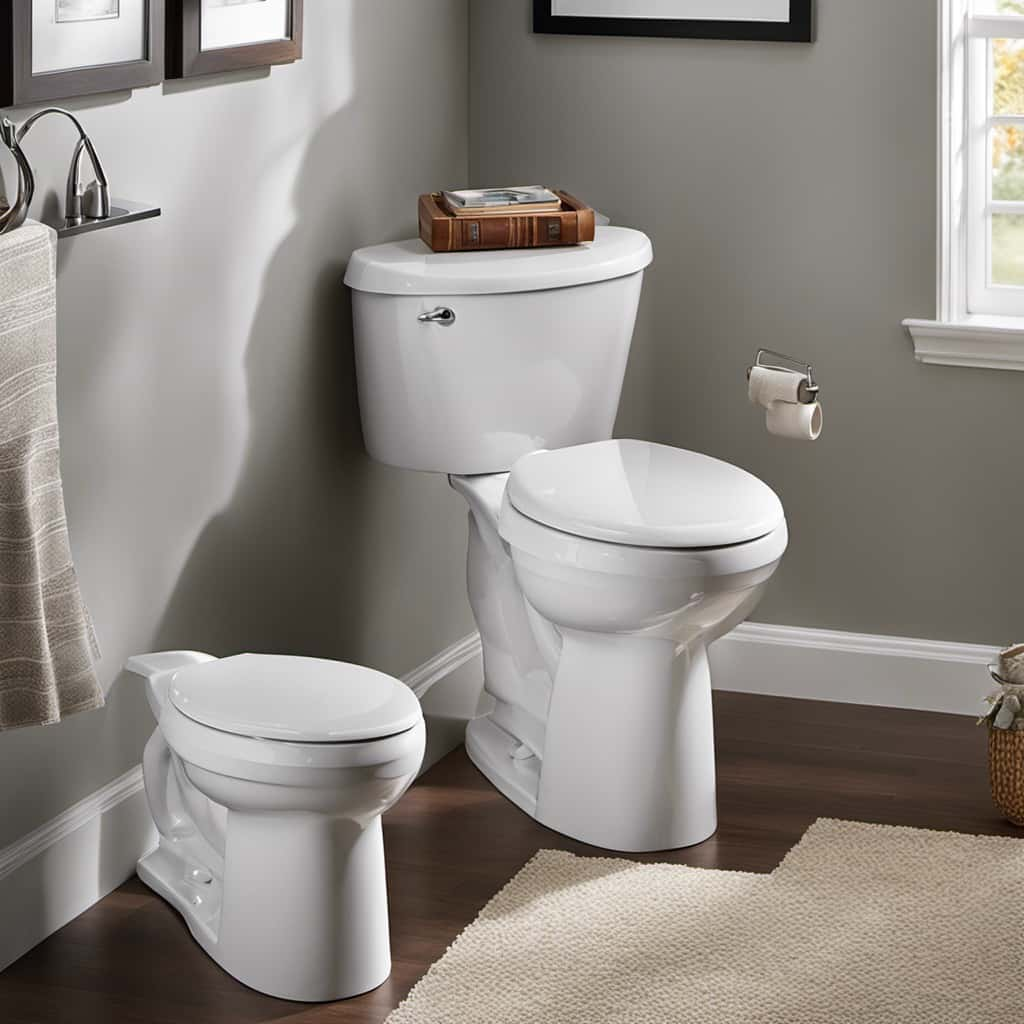
Upgrading to a High-Pressure Toilet
To reduce the likelihood of clogs, we recommend upgrading to a high-pressure toilet. High-pressure toilets are designed to provide a stronger flush, which helps to clear waste more effectively and prevent clogs from occurring.
Here are some key benefits of upgrading to a high-pressure toilet:
- Increased water pressure: High-pressure toilets are designed to operate with higher water pressure, ensuring a more forceful and thorough flush.
- Efficient waste removal: The increased water pressure helps to push waste through the plumbing system more efficiently, reducing the chances of clogs.
- Less maintenance: With a high-pressure toilet, you’ll experience fewer clogs, which means less time and money spent on maintenance and repairs.
- Improved overall performance: Upgrading to a high-pressure toilet will enhance the overall performance of your plumbing system, ensuring a more reliable and efficient flushing experience.
Frequently Asked Questions
How Do I Fix a Clogged Toilet if the Proper Flushing Techniques Mentioned in the Article Don’t Work?
If the proper flushing techniques don’t work to fix a clogged toilet, we can try other toilet unclogging techniques. One effective method is using a plunger to create suction and dislodge the blockage.
Can Using a Bidet Instead of Toilet Paper Help Prevent Clogs?
Using a bidet instead of toilet paper has several benefits, including reducing the environmental impact of toilet paper. Bidets use water to clean, which can help prevent clogs by ensuring proper flushing.

How Often Should I Hire a Professional Plumber for Regular Maintenance and Cleaning of My Toilet?
For regular maintenance and cleaning of our toilet, we should hire a professional plumber periodically. They are skilled in identifying and resolving potential issues, ensuring optimal functionality and reducing the likelihood of clogs.
What Are the Consequences of Flushing Non-Flushable Items, and How Can They Be Avoided?
Flushing non-flushable items can have serious consequences, such as clogs and damage to your plumbing system. To avoid these issues, it is crucial to educate ourselves on what can and cannot be flushed and dispose of non-flushable items properly.
Are There Any Drawbacks or Disadvantages to Upgrading to a High-Pressure Toilet?
When considering the advantages and disadvantages of upgrading to a high-pressure toilet, it is important to evaluate factors such as water consumption, noise levels, and maintenance requirements.
Conclusion
In conclusion, after investigating the truth behind what makes a toilet less likely to clog, it’s clear that proper flushing techniques, mindful toilet paper usage, regular maintenance and cleaning, avoiding flushing non-flushable items, and upgrading to a high-pressure toilet are all essential factors.

By following these guidelines, you can ensure a smoothly functioning toilet and minimize the chances of experiencing clogs. Remember, a little attention and care go a long way in maintaining a trouble-free bathroom experience.
With an impeccable eye for detail and a passion for bathroom-related, Ava leads our editorial team gracefully and precisely.
Under her guidance, Best Modern Toilet has flourished as the go-to resource for modern bathroom enthusiasts. In her free time, you might find Ava exploring antique shops and looking for vintage bathroom fixtures to add to her collection.
Bathtub
Is It Ok to Flush Condoms Down the Toilet

Let’s discuss a crucial topic: the correct way to dispose of condoms.
Flushing condoms down the toilet may seem convenient, but is it really okay? In this article, we’ll explore the potential risks and environmental impact of this practice.
We’ll also discuss the effects on plumbing systems and provide responsible alternatives for condom disposal.
Join us as we delve into this topic, aiming to inform and empower you with the knowledge you need for responsible condom use.
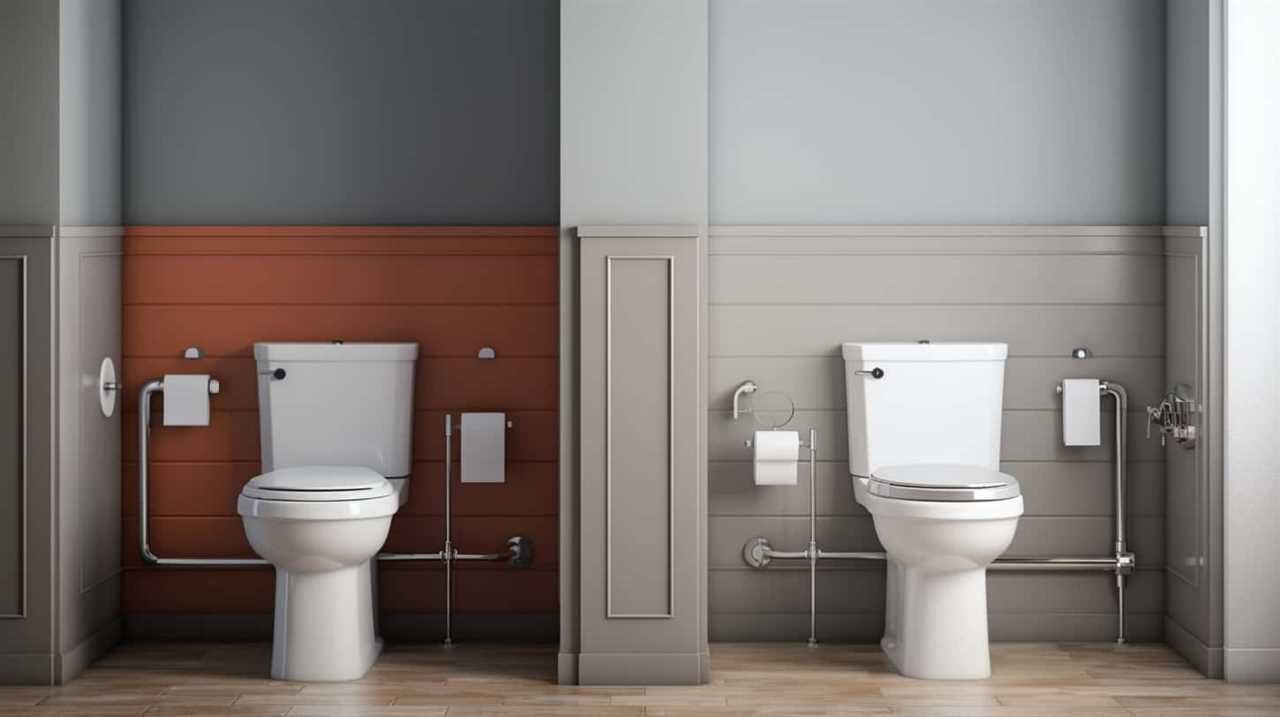
Key Takeaways
- Flushing condoms can lead to clogs and costly repairs in sewage systems.
- Flushed condoms contribute to environmental pollution in water bodies and harm marine life.
- Condoms made of latex or polyurethane are not easily biodegradable and can cause plumbing issues.
- Responsible disposal methods, such as wrapping condoms in tissue and throwing them in the trash, are essential for preventing these risks.
Potential Risks of Flushing Condoms
Flushing condoms down the toilet poses several potential risks that we should be aware of.
One of the main risks is the possibility of clogging the sewage system. Condoms are made of materials that don’t easily break down in water, such as latex or polyurethane. As a result, when flushed down the toilet, they can cause blockages in pipes and sewage treatment plants. These blockages not only disrupt the flow of wastewater, but they can also lead to costly repairs and maintenance.
Moreover, the impact on sewage systems goes beyond clogging. Condoms can end up in rivers, lakes, and oceans, contributing to environmental pollution. It’s important to properly dispose of condoms in designated waste bins to avoid these risks and protect the integrity of sewage systems.
Environmental Impact of Flushing Condoms
When condoms are flushed down the toilet, they contribute to environmental pollution by ending up in rivers, lakes, and oceans. This has significant biodegradability concerns and can have a detrimental impact on aquatic ecosystems. The materials used in condoms, such as latex and polyurethane, are not readily biodegradable and can persist in the environment for a long time. As a result, these non-biodegradable condoms can accumulate in water bodies, posing a threat to marine life. To illustrate the gravity of this issue, consider the following table:
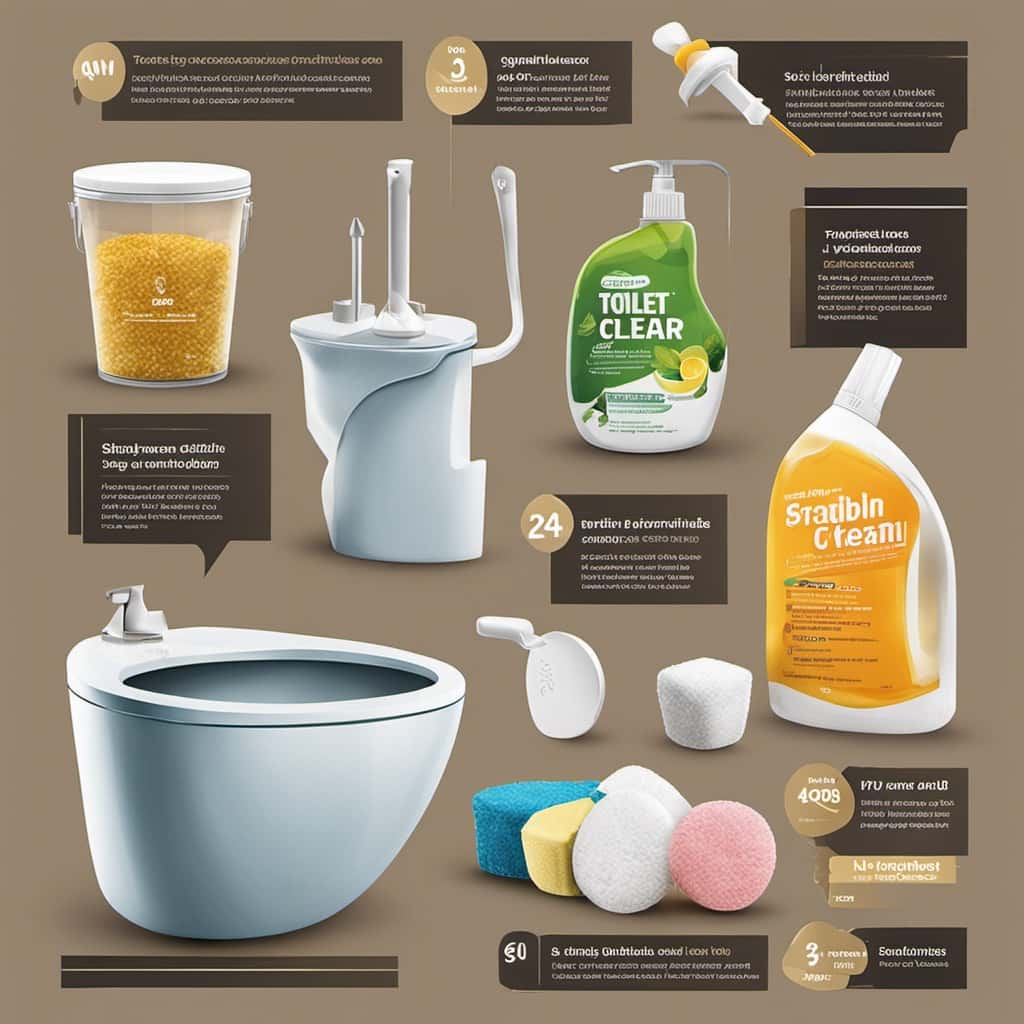
| Environmental Impact of Flushing Condoms | ||
|---|---|---|
| Condom Materials | Biodegradability | Impact on Aquatic Ecosystems |
| Latex | Not readily biodegradable | Can harm marine life |
| Polyurethane | Not readily biodegradable | Can harm marine life |
It is crucial to raise awareness about the negative consequences of flushing condoms and encourage responsible disposal methods to protect our environment.
Effects of Condoms on Plumbing Systems
As we continue our discussion on the environmental impact of flushing condoms, it’s important to consider the effects these contraceptives can have on plumbing systems.
When condoms are flushed down the toilet, they can cause various plumbing issues that may lead to clogging concerns. Condoms are made of materials like latex or polyurethane, which aren’t easily biodegradable. These materials have the potential to cause blockages in pipes, especially in older plumbing systems with narrower pipes.
Additionally, condoms can wrap around other debris in the plumbing, creating a larger obstruction. This can result in reduced water flow, backups, and even costly repairs.
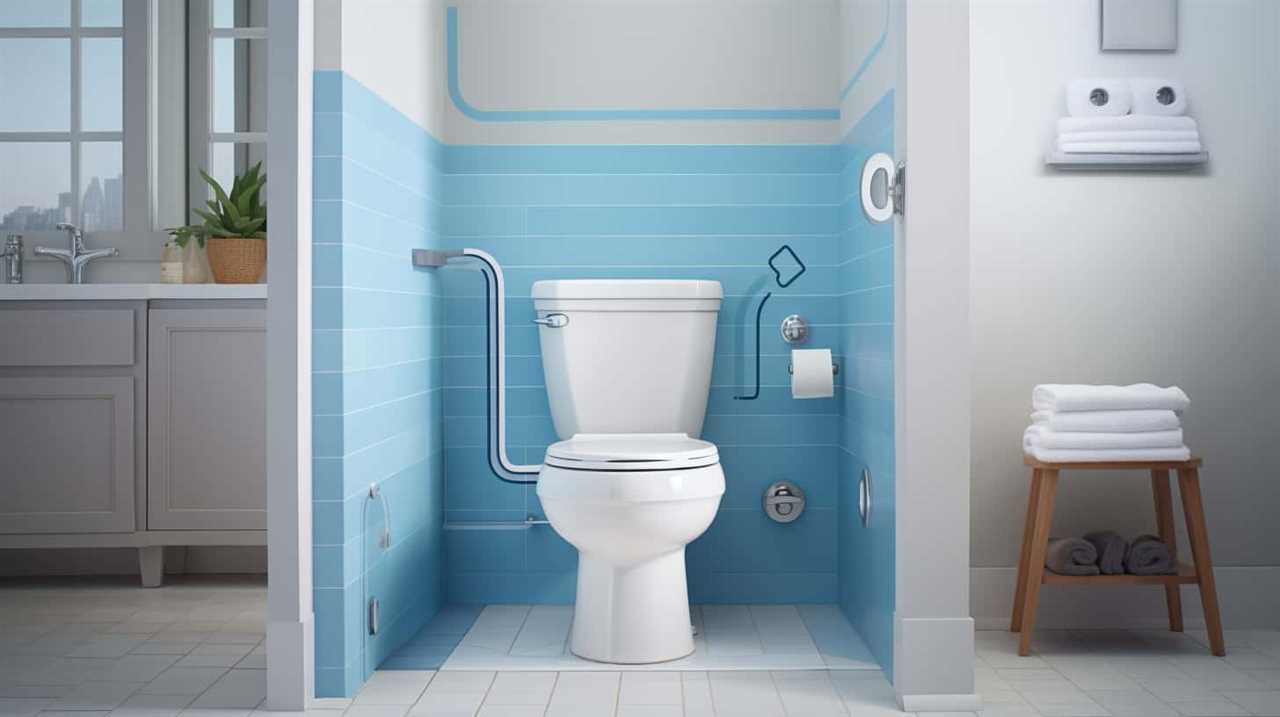
It’s crucial to dispose of condoms properly in trash bins to prevent these plumbing problems and maintain the integrity of the plumbing system.
Alternatives to Flushing Condoms
To avoid the potential plumbing issues associated with flushing condoms, we can explore alternative methods of disposal.
One sustainable condom disposal option is to wrap the used condom in tissue or toilet paper and place it in a waste bin. This prevents clogging of the plumbing system and ensures proper waste management.
Another alternative is to use biodegradable condoms. These condoms are made from materials that can break down naturally over time, reducing their environmental impact. Biodegradable condom options are becoming more widely available and offer a more eco-friendly option for disposal.

Responsible Methods of Condom Disposal
To ensure responsible condom disposal, we can continue the conversation by exploring effective methods that minimize the risk of plumbing issues and promote environmental sustainability.
Proper condom disposal is crucial to prevent blockages in plumbing systems and protect the environment.
Safe condom disposal methods involve wrapping the used condom in tissue or toilet paper and throwing it in the trash. It’s important not to flush condoms down the toilet as they can clog pipes and cause expensive damage.
Another option is to use dedicated condom disposal bags or pouches, which can be found at pharmacies or online. These bags are designed to securely hold used condoms until they can be properly disposed of in the trash.
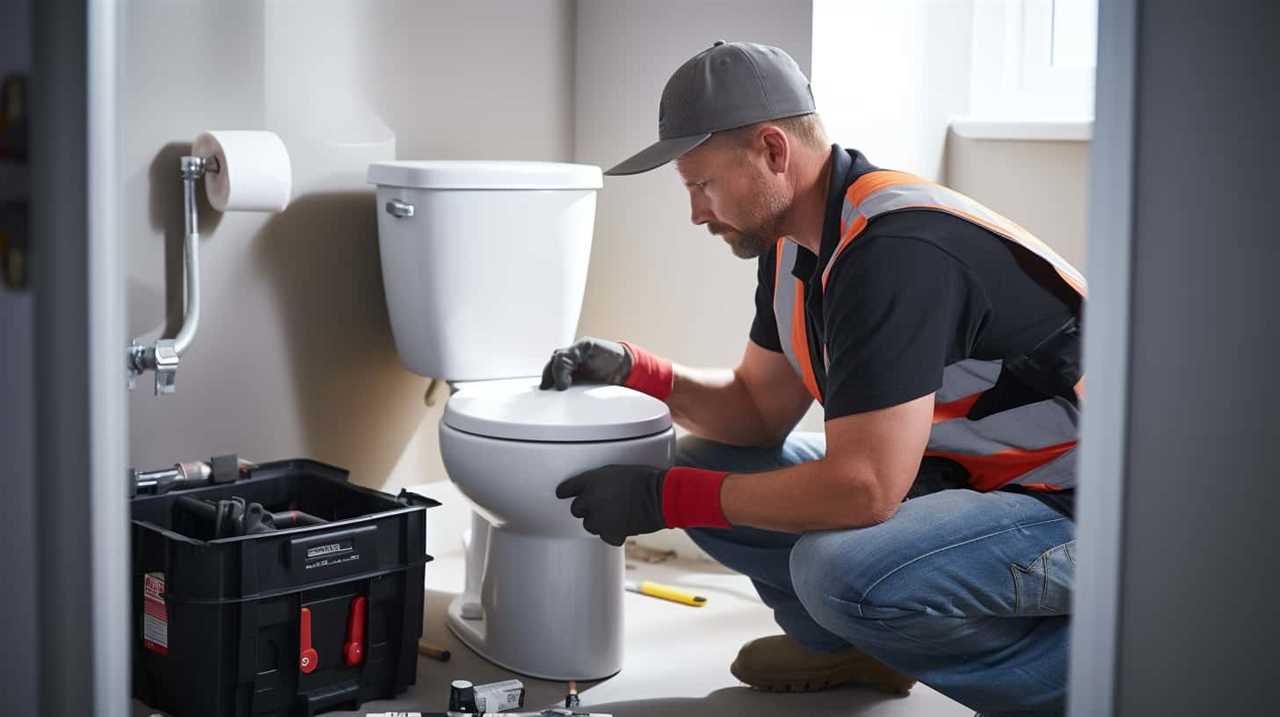
Frequently Asked Questions
Can Flushing Condoms Down the Toilet Cause Damage to the Sewage System?
Flushing condoms down the toilet can cause sewage system damage and health risks. It is important to properly dispose of condoms in the trash to prevent clogs and ensure the integrity of the sewage system.
Are There Any Health Risks Associated With Flushing Condoms?
There can be health risks associated with flushing condoms, as they can clog pipes and damage sewage systems. Proper disposal, such as wrapping them in tissue and throwing them in the trash, is recommended.
What Are the Potential Consequences of Flushing Condoms on the Environment?
Flushing condoms down the toilet can have potential pollution and environmental impact. Proper disposal is crucial to prevent clogging, sewage system damage, and harm to aquatic life. It is not recommended.
Are There Any Alternative Methods of Disposing of Condoms Besides Flushing?
When considering the proper disposal of condoms, it’s essential to explore alternative methods. Flushing condoms down the toilet may not be advisable, but there are other options available that ensure both convenience and environmental responsibility.
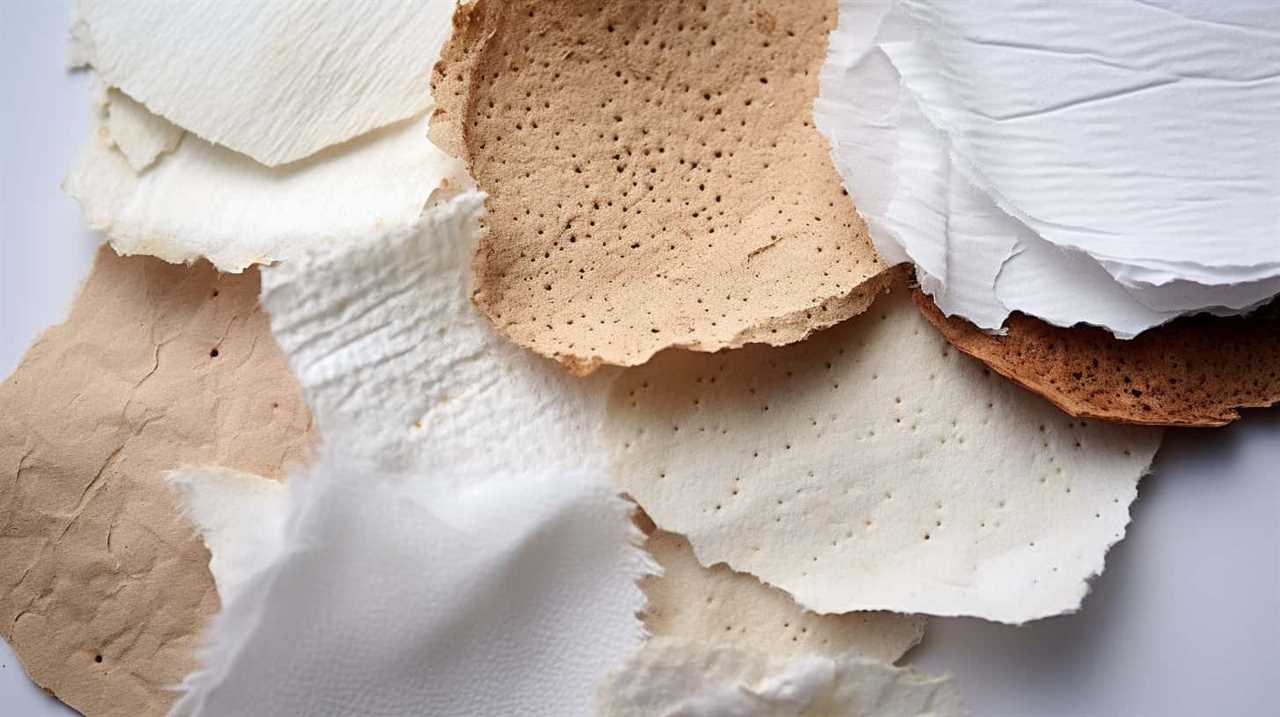
How Can Individuals Responsibly Dispose of Condoms to Minimize Their Impact on the Environment?
To minimize our impact on the environment, we must practice sustainable condom disposal. We can explore eco-friendly methods such as wrapping condoms in tissue and disposing them in the trash, or using biodegradable condom options.
Conclusion
In conclusion, it’s indeed a brilliant idea to flush condoms down the toilet! Who needs to consider the potential risks of clogged pipes, sewer backups, or the environmental impact?
Let’s just ignore the fact that condoms can wreak havoc on plumbing systems and opt for the convenient route. After all, who needs responsible methods of condom disposal when we can embrace the thrill of a plumbing disaster?
The choice is yours, but remember, sarcasm does wonders for analytical objectivity.

With an impeccable eye for detail and a passion for bathroom-related, Ava leads our editorial team gracefully and precisely.
Under her guidance, Best Modern Toilet has flourished as the go-to resource for modern bathroom enthusiasts. In her free time, you might find Ava exploring antique shops and looking for vintage bathroom fixtures to add to her collection.
Bathtub
Should I Close the Toilet Seat After Pooping
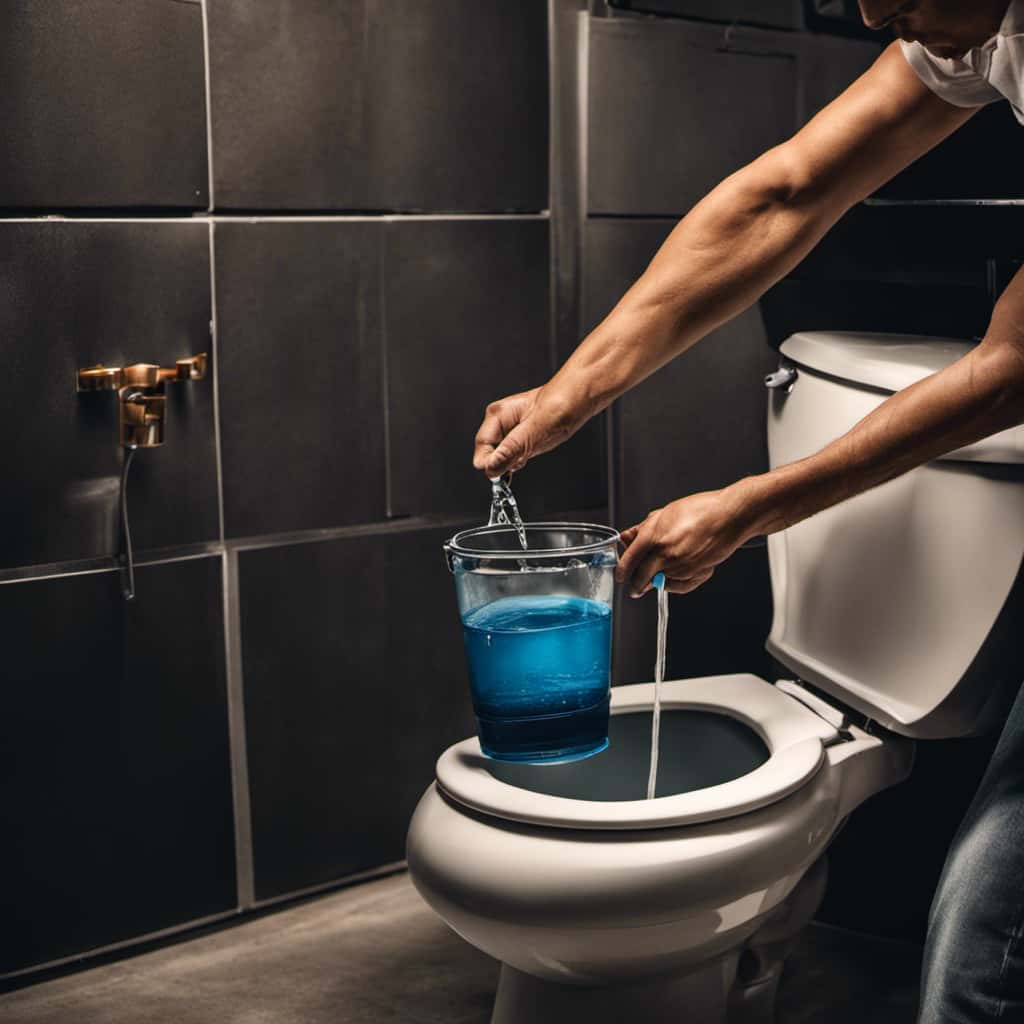
Similar to a ship’s crew discussing which way to navigate, we frequently contemplate the timeless query: should we shut the toilet seat after using it?
In this article, we explore the hygiene benefits, potential health risks, and courtesy arguments for closing the seat.
We also delve into the reasons why some opt to leave it open.
Join us as we navigate the murky waters of toilet seat etiquette and help you make an informed decision based on facts and considerations.
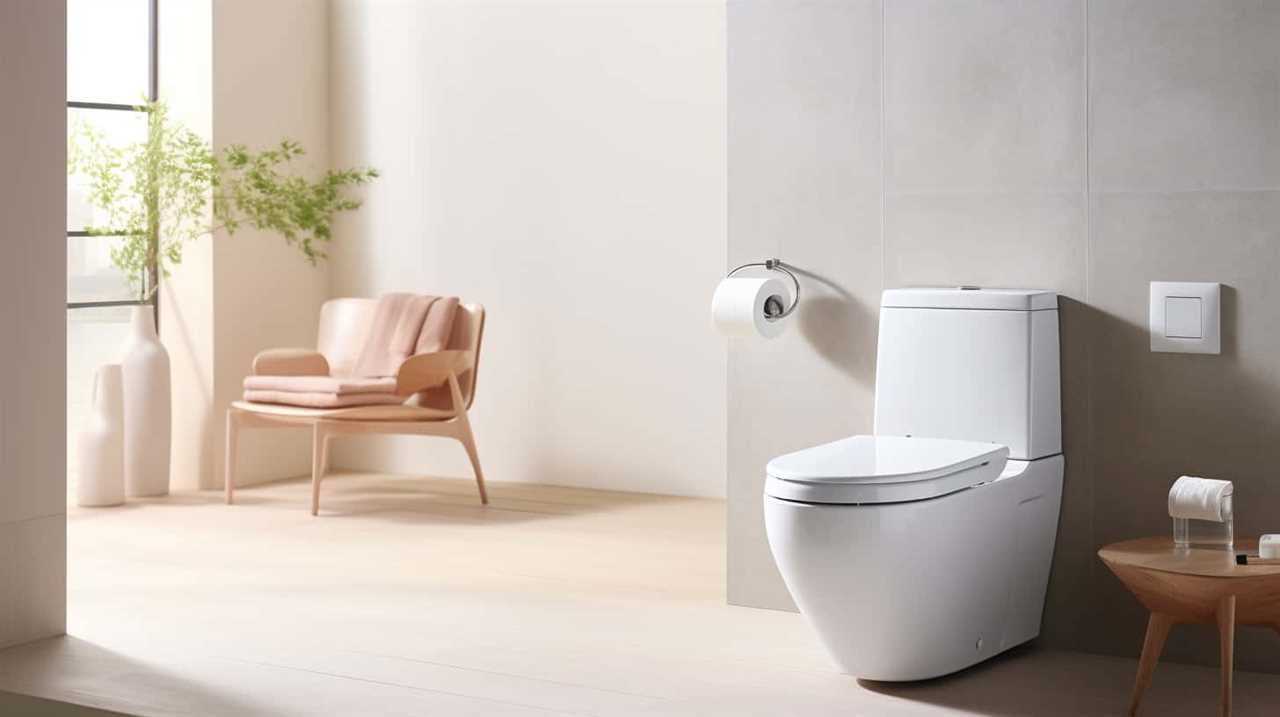
Key Takeaways
- Closing the toilet seat after pooping helps prevent the spread of germs and maintains cleanliness in the bathroom.
- Leaving the seat open increases the risk of spreading germs and bacteria throughout the bathroom, potentially causing illnesses.
- Closing the seat shows respect and consideration for others, preventing accidental contact with germs and reducing the risk of someone falling into the toilet bowl.
- When deciding whether to close the seat, it is important to consider personal preferences, household dynamics, and the importance of reaching a mutual agreement to maintain harmony in shared spaces.
Hygiene Benefits of Closing the Seat
Closing the toilet seat after using it can help prevent the spread of germs and maintain cleanliness in the bathroom. By closing the seat, you create a barrier that prevents bacteria and other microorganisms from escaping the toilet bowl and contaminating the surrounding area. This simple act of hygiene can significantly reduce the risk of illness and infection.
When the seat is left open, it allows for the dispersion of microscopic droplets that may contain harmful bacteria, increasing the chances of cross-contamination. Closing the toilet seat also prevents items from accidentally falling into the bowl, ensuring that the surface remains clean and free from potential sources of contamination.
Potential Health Risks of Leaving the Seat Open
Leaving the toilet seat open can increase the risk of spreading germs and bacteria throughout the bathroom. When the seat is left open, particles from flushing can be dispersed into the air, landing on various surfaces. These particles may contain harmful microorganisms that can cause illnesses such as diarrhea, urinary tract infections, and respiratory infections. To illustrate the potential health risks of leaving the seat open, consider the following table:
| Risks | Cleanliness |
|---|---|
| Spread of germs | Reduced hygiene |
| Increased infection | Decreased sanitation |
| Higher risk of illness | Poor bathroom hygiene |
The Courtesy Argument for Closing the Seat
After we finish using the toilet, it’s considerate to close the seat for the next person. This simple act shows respect and consideration for others who may need to use the bathroom after us. While some may argue that leaving the seat open isn’t a big deal, the courtesy argument for closing the seat holds its ground. Here are three reasons why closing the seat is the polite thing to do:
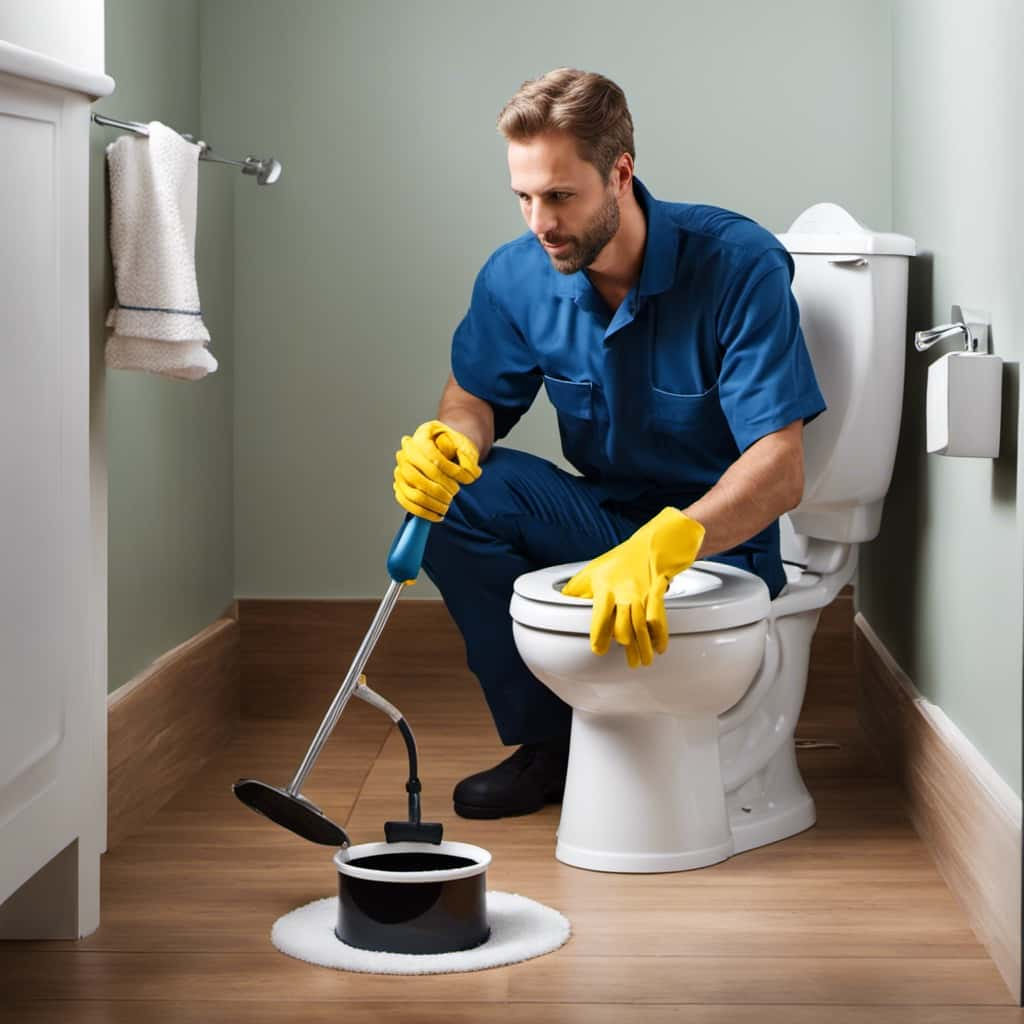
- Hygiene: Closing the seat prevents any accidental contact with germs or bacteria that may be present in the toilet bowl. It helps maintain a clean and sanitary environment for everyone.
- Safety: A closed seat reduces the risk of someone accidentally falling into the toilet bowl, especially in households with young children or elderly individuals.
- Cultural perspectives: Closing the seat is a common practice in many cultures, seen as a sign of cleanliness and respect. By adhering to this etiquette, we can show our understanding and consideration for diverse cultural norms.
Reasons Why Some People Choose to Leave the Seat Open
While it’s important to consider the courtesy argument for closing the seat, some people choose to leave it open for their own personal reasons. Toilet seat etiquette is a matter of individual preference, and there are several factors that might influence this choice.
Some individuals may have physical limitations or disabilities that make it difficult to close the seat after use. Others may find it more convenient to leave the seat open, especially in households where multiple people use the bathroom. Additionally, some individuals may have cultural or personal beliefs that affect their decision to leave the seat open.
Ultimately, each person’s choice regarding the toilet seat should be respected, as long as they’re mindful of the preferences and needs of others who share the same space.
Considerations for Making Your Own Decision
When making our own decision about whether to close the toilet seat after pooping, there are several factors to consider. Here are three key considerations to keep in mind:

- Toilet Seat Etiquette: Proper toilet seat etiquette is an important aspect to consider. Closing the toilet seat after using it shows respect for others who might use the bathroom next, ensuring a clean and tidy environment for everyone.
- Personal Preferences: Your own personal preferences should also play a role in making this decision. Some people prefer to close the toilet seat for hygienic reasons or to prevent pets from drinking out of the bowl, while others may leave it open for convenience or personal habits.
- Household Dynamics: The dynamics of your household can also influence your decision. If you live alone, you have the freedom to choose what works best for you. However, if you live with others, it’s important to consider their preferences and reach a mutual agreement to maintain harmony.
Frequently Asked Questions
Are There Any Specific Bacteria or Germs That Can Be Easily Transmitted From Leaving the Toilet Seat Open?
Leaving the toilet seat open can expose us to specific bacteria and germs that are easily transmitted. It’s important to close the toilet seat to minimize the risk of spreading these harmful microorganisms.
How Does Leaving the Toilet Seat Open Affect the Overall Cleanliness of the Bathroom?
Leaving the toilet seat open can have a negative effect on bathroom hygiene. It allows for the spread of bacteria and unpleasant odors to linger. Closing the seat after use helps maintain cleanliness and control odors.
Are There Any Potential Health Risks Associated With Closing the Toilet Seat After Pooping?
Closing the toilet seat after pooping may have potential hygiene risks. It can trap bacteria and odors, impacting bathroom sanitation. However, regularly cleaning the toilet and practicing good hand hygiene can help mitigate these risks.
What Are the Social Implications of Leaving the Toilet Seat Open in Public Restrooms?
When it comes to social etiquette in public restrooms, closing the toilet seat after use is considered good hygiene. It shows respect for others and helps maintain cleanliness, preventing potential health risks.
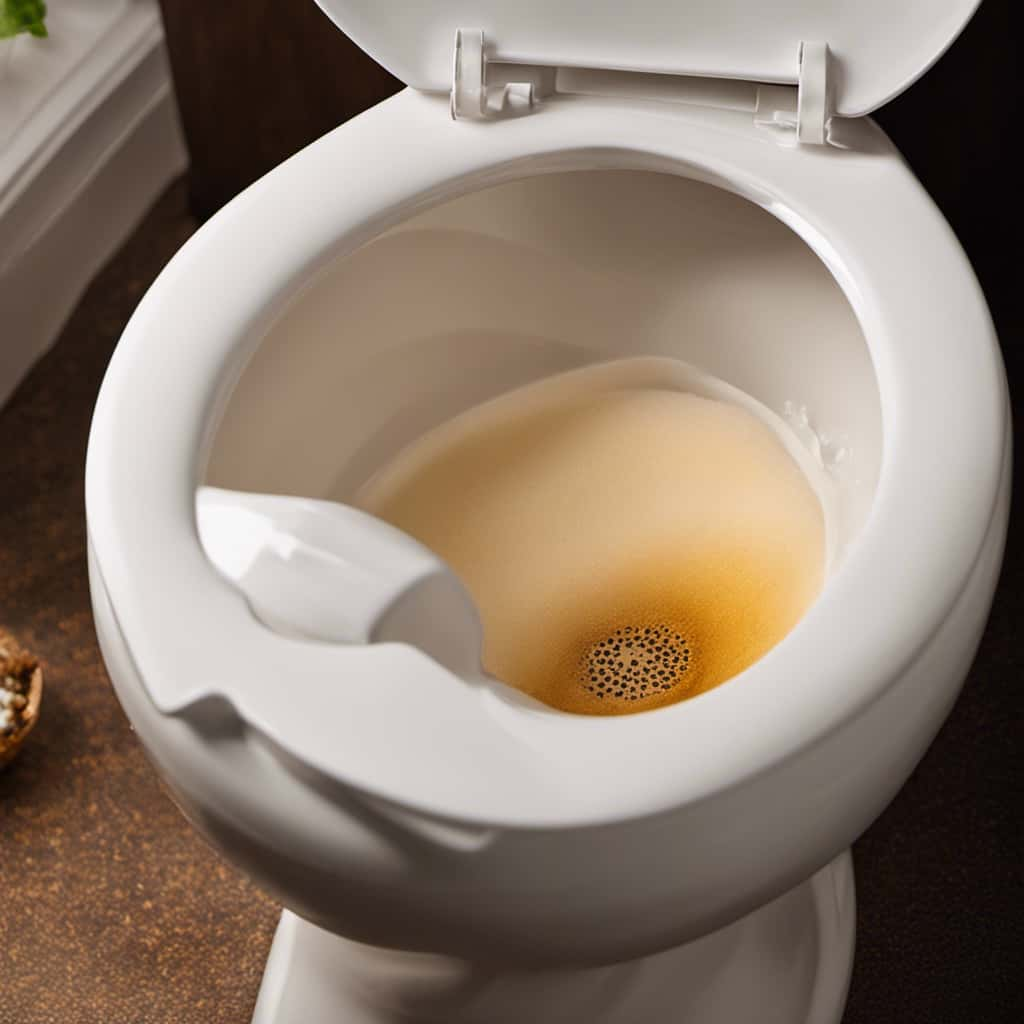
How Can Personal Preferences and Cultural Norms Influence the Decision to Close or Leave the Toilet Seat Open After Using the Bathroom?
When considering whether to close the toilet seat after using it, personal preferences and cultural norms play a significant role. Our individual choices and societal expectations shape our decision-making in this matter.
Conclusion
In conclusion, closing the toilet seat after pooping is a hygienic and considerate practice. It helps prevent the spread of germs and potential health risks associated with leaving it open.
Like closing the door to keep out unwanted guests, closing the toilet seat is a simple act of courtesy that can make a big difference in maintaining a clean and healthy bathroom environment.
So remember, just like shutting the front door to keep the cold out, close the toilet seat to keep the germs in!

With an impeccable eye for detail and a passion for bathroom-related, Ava leads our editorial team gracefully and precisely.
Under her guidance, Best Modern Toilet has flourished as the go-to resource for modern bathroom enthusiasts. In her free time, you might find Ava exploring antique shops and looking for vintage bathroom fixtures to add to her collection.
-

 Bathtub2 months ago
Bathtub2 months agoAre Clorox Toilet Wand Refills Septic Safe
-

 Reviews2 months ago
Reviews2 months agoLoupusuo Luxury Smart Toilet Review [2024]
-

 Reviews2 months ago
Reviews2 months agoSimple Project Modern Smart Toilet Review [2024]
-

 FAQ - Advanced Bathroom Queries2 months ago
FAQ - Advanced Bathroom Queries2 months agoWhat to Do if You Accidentally Flush a Paper Towel
-

 Toilet Brands2 months ago
Toilet Brands2 months agoCan You Put Toilet Paper Down the Toilet in Cyprus
-

 Reviews2 months ago
Reviews2 months agoLDian Smart Toilet Review: Luxury and Hygiene Combined [2024]
-

 FAQ - Advanced Bathroom Queries2 months ago
FAQ - Advanced Bathroom Queries2 months agoWhat to Do if a Toilet Paper Roll Gets Flushed Down the Toilet
-

 Reviews2 months ago
Reviews2 months agoWhich Is Better Flush Valve or Flush Tank






















